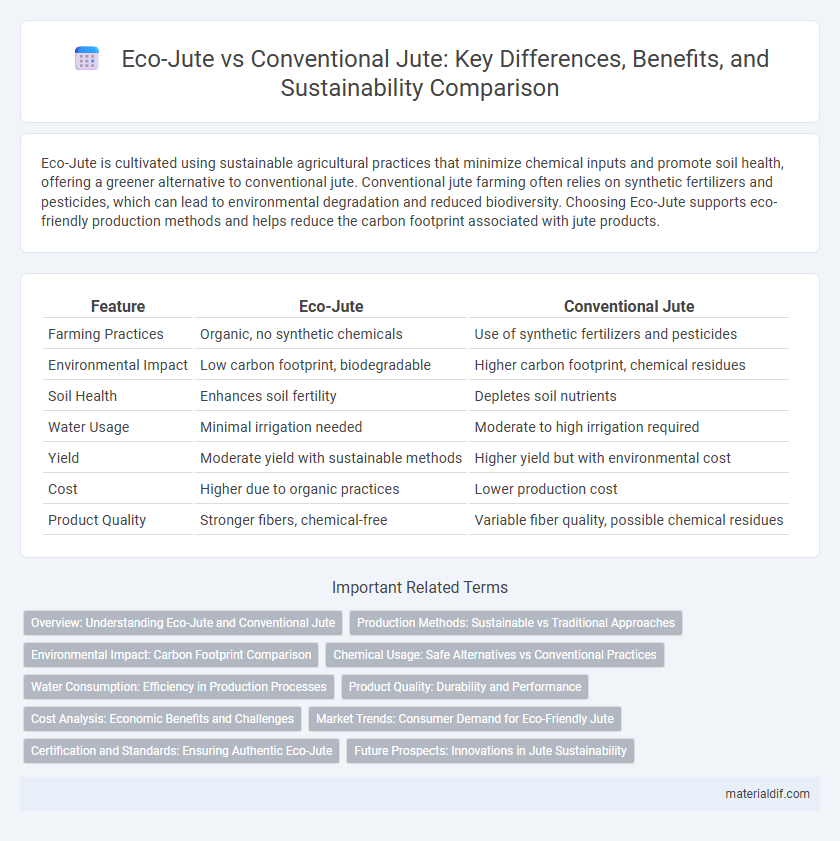Eco-Jute is cultivated using sustainable agricultural practices that minimize chemical inputs and promote soil health, offering a greener alternative to conventional jute. Conventional jute farming often relies on synthetic fertilizers and pesticides, which can lead to environmental degradation and reduced biodiversity. Choosing Eco-Jute supports eco-friendly production methods and helps reduce the carbon footprint associated with jute products.
Table of Comparison
| Feature | Eco-Jute | Conventional Jute |
|---|---|---|
| Farming Practices | Organic, no synthetic chemicals | Use of synthetic fertilizers and pesticides |
| Environmental Impact | Low carbon footprint, biodegradable | Higher carbon footprint, chemical residues |
| Soil Health | Enhances soil fertility | Depletes soil nutrients |
| Water Usage | Minimal irrigation needed | Moderate to high irrigation required |
| Yield | Moderate yield with sustainable methods | Higher yield but with environmental cost |
| Cost | Higher due to organic practices | Lower production cost |
| Product Quality | Stronger fibers, chemical-free | Variable fiber quality, possible chemical residues |
Overview: Understanding Eco-Jute and Conventional Jute
Eco-jute represents an environmentally friendly alternative to conventional jute, produced using sustainable farming practices that reduce chemical usage and minimize water consumption. Conventional jute, widely cultivated in regions like India and Bangladesh, relies on traditional agricultural methods that often involve synthetic fertilizers and pesticides. Understanding the differences helps promote sustainable textile and packaging industries by highlighting the ecological benefits of eco-jute over its conventional counterpart.
Production Methods: Sustainable vs Traditional Approaches
Eco-jute production emphasizes sustainable agricultural practices such as organic farming, minimal chemical use, and water conservation techniques, reducing environmental impact compared to conventional jute cultivation. Traditional jute production relies heavily on synthetic fertilizers, pesticides, and extensive water use, contributing to soil degradation and pollution. Sustainable methods in eco-jute enhance soil health and biodiversity, promoting a more environmentally friendly alternative to conventional approaches.
Environmental Impact: Carbon Footprint Comparison
Eco-jute cultivation significantly reduces the carbon footprint compared to conventional jute by employing sustainable farming practices that minimize synthetic fertilizer and pesticide use, resulting in lower greenhouse gas emissions. Life cycle assessments indicate that eco-jute production emits up to 30% less CO2 equivalent, contributing to improved soil health and increased carbon sequestration during growth. This environmental advantage makes eco-jute a preferable choice for reducing the textile industry's carbon impact.
Chemical Usage: Safe Alternatives vs Conventional Practices
Eco-Jute production minimizes chemical usage by employing natural pesticides and organic fertilizers, significantly reducing soil and water contamination. Conventional jute cultivation relies heavily on synthetic chemicals and pesticides, which contribute to environmental degradation and health risks for farmers. Safe alternatives in eco-jute farming promote sustainable agriculture while maintaining fiber quality and yield.
Water Consumption: Efficiency in Production Processes
Eco-Jute production significantly reduces water consumption compared to conventional jute, utilizing advanced irrigation techniques and rain-fed farming to enhance water efficiency. Studies indicate that eco-jute farming can decrease water usage by up to 40%, minimizing environmental impact while maintaining fiber quality. This efficient water management supports sustainable agriculture and aligns with global efforts to conserve freshwater resources in textile production.
Product Quality: Durability and Performance
Eco-Jute products exhibit enhanced durability due to sustainable cultivation practices that reduce chemical exposure, preserving fiber strength and resilience. Conventional jute often undergoes intensive chemical treatments that may weaken fibers over time, compromising long-term performance. Superior product quality in Eco-Jute translates to higher tensile strength and better resistance to wear, making it ideal for environmentally conscious consumers seeking durable, high-performance materials.
Cost Analysis: Economic Benefits and Challenges
Eco-jute production often incurs higher initial costs due to organic farming inputs and certification expenses, but it benefits from premium market pricing and growing consumer demand for sustainable products. Conventional jute remains more cost-effective with established supply chains and lower cultivation expenses, yet faces increasing regulatory pressures and market volatility linked to environmental concerns. Evaluating long-term economic benefits suggests eco-jute investment supports green branding and potential export opportunities despite short-term financial challenges.
Market Trends: Consumer Demand for Eco-Friendly Jute
Rising consumer demand for sustainable products drives significant market growth in eco-jute, which is cultivated using organic farming practices without synthetic chemicals, contrasting conventional jute's reliance on agrochemicals. Eco-jute products, including bags, textiles, and home decor, align with increasing environmental regulations and corporate sustainability goals, creating a strong competitive advantage in global markets. Market analytics indicate a projected CAGR of over 12% for eco-jute goods through 2030, fueled by heightened awareness of eco-friendly alternatives among millennials and Gen Z consumers.
Certification and Standards: Ensuring Authentic Eco-Jute
Eco-Jute products are distinguished by certifications such as GOTS (Global Organic Textile Standard) and OEKO-TEX, guaranteeing adherence to stringent environmental and social criteria. Conventional jute often lacks these verifications, making it challenging to confirm sustainable farming and processing methods. Authentic eco-jute certification ensures reduced chemical usage, fair labor practices, and minimal ecological impact throughout the product lifecycle.
Future Prospects: Innovations in Jute Sustainability
Eco-Jute innovations emphasize biodegradable treatments and organic farming practices that reduce environmental impact compared to conventional jute cultivation. Advances in genetic modification and natural pest resistance aim to improve yield and fiber strength while maintaining soil health. Future prospects include integrating smart agriculture technologies to optimize water usage and maximize sustainable production, positioning eco-jute as a key material in green industries.
Eco-Jute vs Conventional Jute Infographic

 materialdif.com
materialdif.com